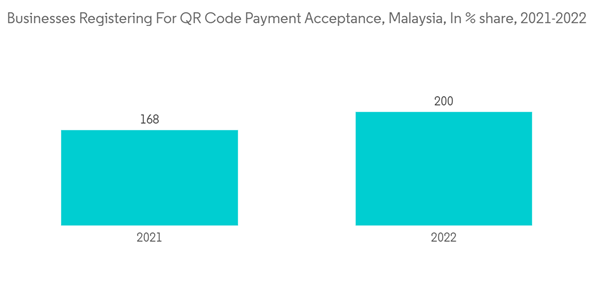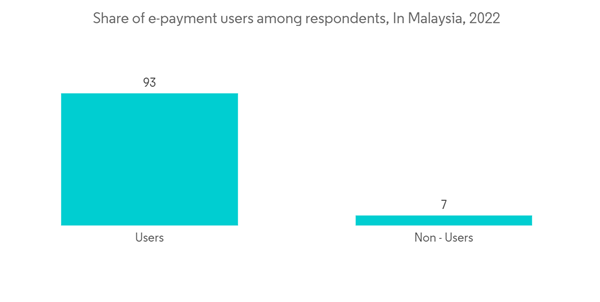The Malaysia Fintech Market size in terms of transaction value is expected to grow from USD 46.63 billion in 2024 to USD 96.09 billion by 2029, at a CAGR of 15.56% during the forecast period (2024-2029).
There was a negative impact of COVID-19 on the Malaysian Fintech Market in the first 2 quarters of FY 2020. The coronavirus pandemic impacted the proper functioning of various industries across regions. It affected the Malaysian Fintech Market and the technology industry very badly. It was primarily due to reduced transactions because of the imposed lockdown and, thus halt in businesses and money transfers or investments. The rise in the fintech industry began in the last 2 quarters of 2020 and resulted in positive growth. Malaysia's digital shift was ongoing for the past decade, but the pandemic accelerated digital banking adoption. In 2020, online and mobile banking penetration reached 112.5% and 61.8%, respectively, and USD 100.79 million mobile banking transactions were conducted - a 125% jump compared to the previous year.
Fintech now became a central part of Malaysia's financial sector, with considerable scope for expansion, according to a recent IMF analysis. With its growing middle class, high mobile phone usage, and strong government support for the digitization of the economy, Malaysian businesses and consumers appear ready to embrace fintech technology. Digital payments and wallets are leading the way in Malaysian fintech, followed shortly by insurtech, digital remittances, blockchain, crowdfunding and other forms of financial technology.
Internet banking in Malaysia quadrupled over the last decade, supported by 4G coverage and affordable data to promote mobile banking. The financial sector landscape also changed in the past few years, with physical commercial bank branches reducing and ATMs declining. All these statistics hint towards the fact that financial institutions started shifting towards adopting fintech, which is in sharp contrast to the initial scepticism it received from them.
Wealthtech also picked up with new digital investment management accounts opened last year. In alternative financing, capital raised on equity crowdfunding platforms jumped more than 457%, while peer-to-peer (P2P) lending value rose over 20%.
This product will be delivered within 2 business days.
There was a negative impact of COVID-19 on the Malaysian Fintech Market in the first 2 quarters of FY 2020. The coronavirus pandemic impacted the proper functioning of various industries across regions. It affected the Malaysian Fintech Market and the technology industry very badly. It was primarily due to reduced transactions because of the imposed lockdown and, thus halt in businesses and money transfers or investments. The rise in the fintech industry began in the last 2 quarters of 2020 and resulted in positive growth. Malaysia's digital shift was ongoing for the past decade, but the pandemic accelerated digital banking adoption. In 2020, online and mobile banking penetration reached 112.5% and 61.8%, respectively, and USD 100.79 million mobile banking transactions were conducted - a 125% jump compared to the previous year.
Fintech now became a central part of Malaysia's financial sector, with considerable scope for expansion, according to a recent IMF analysis. With its growing middle class, high mobile phone usage, and strong government support for the digitization of the economy, Malaysian businesses and consumers appear ready to embrace fintech technology. Digital payments and wallets are leading the way in Malaysian fintech, followed shortly by insurtech, digital remittances, blockchain, crowdfunding and other forms of financial technology.
Internet banking in Malaysia quadrupled over the last decade, supported by 4G coverage and affordable data to promote mobile banking. The financial sector landscape also changed in the past few years, with physical commercial bank branches reducing and ATMs declining. All these statistics hint towards the fact that financial institutions started shifting towards adopting fintech, which is in sharp contrast to the initial scepticism it received from them.
Malaysia Fintech Market Trends
Regulatory Changes Ignited Fintech Adoption
Malaysia's government's Movement Control Order (MCO) functioned as a catalyst, assisting in the addition of 3 million new mobile banking service customers last year and driving e-wallet usage and adoption to new highs. Merchants jumped on board fast, with over 400,000 new firms registering for QR code payment processing, a 164% increase from 2022. Numerous regulatory improvements were implemented in 2022 to assist digital finance prosperity.Digital e-Finance Adoption on the Rise
The successful adoption of digital finance was also observed across other fintech segments, including e-remittances, wealth tech, alternative financing, and cryptocurrency trading. In e-remittance, total transaction value grew by 106% last year. With USD 5.54 billion worth of remittances being sent out, e-remittance saw its market share grow from 14% to 25%, signaling that Malaysians are rapidly ditching traditional providers for a new age, lower-cost e-remittance provider according to fintech news.Wealthtech also picked up with new digital investment management accounts opened last year. In alternative financing, capital raised on equity crowdfunding platforms jumped more than 457%, while peer-to-peer (P2P) lending value rose over 20%.
Malaysia Fintech Industry Overview
The Malaysia Fintech Market is highly competitive and fragmented as Malaysia is the largest market of the Fintech Industry throughout Asia. The Malaysia FinTech ecosystem is developing faster each year, with more companies and incumbents seeking new opportunities to collaborate, connect and co-create. It will cater to numerous clients and cover various services such as digital payments, alternative finance, wealth management, and blockchain. Malaysia groups such as MyCash Online, Jirnexu, and Mobi are focusing on innovating the FinTech industry and leading the Malaysia Fintech Market to new heights. Some major players are Jirnexu, MyCash Online, Capital Bay, PitchIN, MHub, etc.Additional Benefits:
- The market estimate (ME) sheet in Excel format
- 3 months of analyst support
This product will be delivered within 2 business days.
Table of Contents
1 INTRODUCTION
4 MARKET DYNAMICS AND INSIGHTS
5 MARKET SEGMENTATION
6 COMPETITIVE LANDSCAPE










